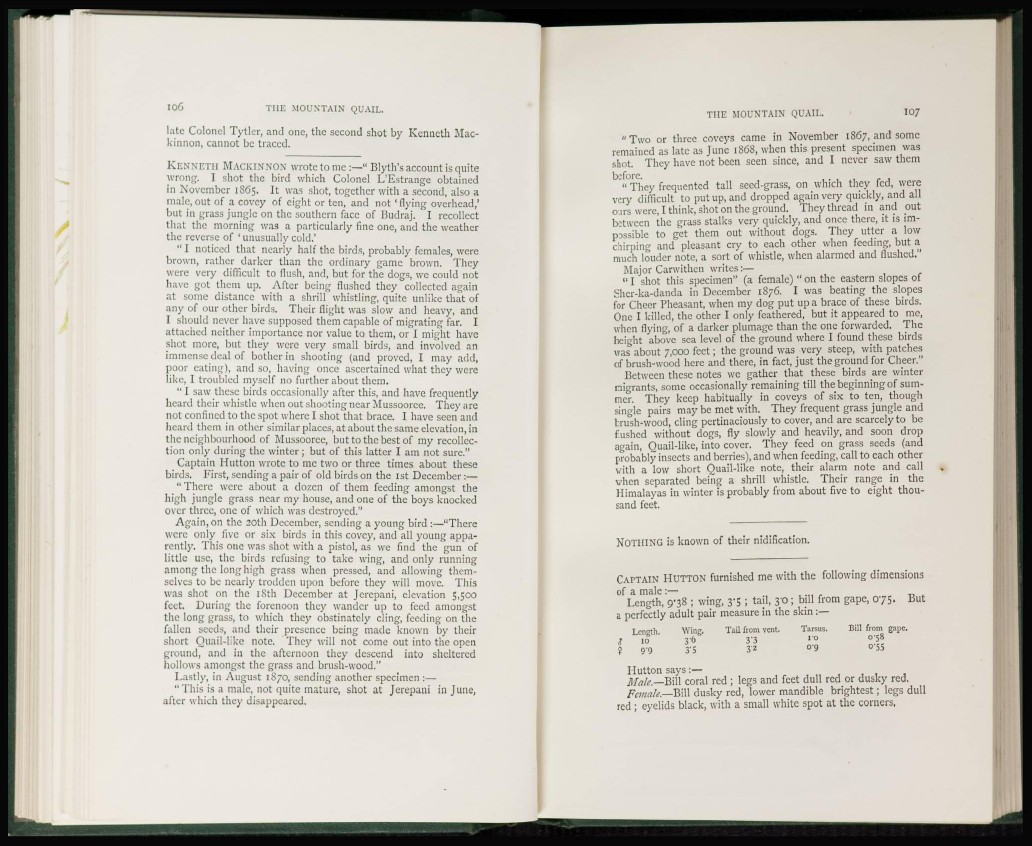
io6 THE MOUNTAIN QUAIL.
late Colonel Tytler, and one, the second shot by Kenneth Mackinnon,
cannot be traced.
KENNETH MACKINNON wrote to me :—" Blyth's account is quite
wrong. I shot the bird which Colonel L'Estrange obtained
in November 1865. It was shot, together with a second, also a
male, out of a covey of eight or ten, and not ' flying overhead,'
but in grass jungle on the southern face of Budraj. I recollect
that the morning was a particularly fine one, and the weather
the reverse of ' unusually cold.'
" I noticed that nearly half the birds, probably females, were
brown, rather darker than the ordinary game brown. They
were very difficult to flush, and, but for the dogs, we could not
have got them up. After being flushed they collected again
at some distance with a shrill whistling, quite unlike that of
any of our other birds. Their flight was slow and heavy, and
I should never have supposed them capable of migrating far. I
attached neither importance nor value to them, or I might have
shot more, but they were very small birds, and involved an
immense deal of bother in shooting (and proved, I may add,
poor eating), and so, having once ascertained what they were
like, I troubled myself no further about them.
" I saw these birds occasionally after this, and have frequently
heard their whistle when out shooting near Mussoorce. They are
not confined to the spot where I shot that brace. I have seen and
heard them in other similar places, at about the same elevation, in
the neighbourhood of Mussoorce, but to the best of my recollection
only during the winter ; but of this latter I am not sure"
Captain Mutton wrote to me two or three times about these
birds. First, sending a pair of old birds on the 1st December :—
" There were about a dozen of them feeding amongst the
high jungle grass near my house, and one of the boys knocked
over three, one of which was destroyed."
Again, on the 20th December, sending a young bird :—"There
were only five or six birds in this covey, and all young apparently.
This one was shot with a pistol, as we find the gun of
little use, the birds refusing to take wing, and only running
among the long high grass when pressed, and allowing themselves
to be nearly trodden upon before they will move. This
was shot on the 18th December at Jcrcpani, elevation 5,500
feet. During the forenoon they wander up to feed amongst
the long grass, to which they obstinately cling, feeding on the
fallen seeds, and their presence being made known by their
short Quail-like note. They will not come out into the open
ground, and in the afternoon they descend into sheltered
hollows amongst the grass and brush-wood."
Lastly, in August 1S70, sending another specimen :—
" This is a male, not quite mature, shot at Jerepani in June,
after which they disappeared.
THE MOUNTAIN QUAIL. 107
"Two or three coveys came in November 1867, and some
remained as late as June 1868, when this present specimen was
shot. They have not been seen since, and I never saw them
before.
" They frequented tall seed-grass, on which they fed, were
very difficult to put up, and dropped again very quickly, and all
ours were, I think, shot on the ground. They thread in and out
between the grass stalks very quickly, and once there, it is impossible
to get them out without dogs. They utter a low
chirping and pleasant cry to each other when feeding, but a
much louder note, a sort of whistle, when alarmed and flushed."
Major Carwithen writes:—
" I shot this specimen" (a female) " on the eastern slopes of
Sher-ka-danda in December 1876. I was beating the slopes
for Cheer Pheasant, when my dog put up a brace of these birds.
One I killed, the other I only feathered, but it appeared to me,
when flying, of a darker plumage than the one forwarded. The
height above sea level of the ground where I found these birds
was about 7,000 feet; the ground was very steep, with patches
of brush-wood here and there, in fact, just the ground for Cheer."
Between these notes we gather that these birds are winter
migrants, some occasionally remaining till the beginning of summer.
They keep habitually in coveys of six to ten, though
single pairs may be met with. They frequent grass jungle and
brush-wood, cling pertinaciously to cover, and are scarcely to be
flushed without dogs, fly slowly and heavily, and soon drop
again, Quail-like, into cover. They feed on grass seeds (and
probably insects and berries), and when feeding, call to each other
with a low short Quail-like note, their alarm note and call
when separated being a shrill whistle. Their range in the
Himalayas in winter is probably from about five to eight thousand
feet.
NOTHING is known of their nidification.
CAPTAIN HUTTON furnished me with the following dimensions
of a male :—
Length, c/38 ; wing, 3-5 ; tail, 3'0 ; bill from gape, 075. But
a perfectly adult pair measure in the skin :—
Length. Wing. Tail from vent. Tarsus. Bill from gape.
i 10 3'6 33 10 0-58
¥ 99 35 32 0-9 0-55
Hutton says:—
Male.—Bill coral red ; legs and feet dull red or dusky red.
Female.—Bill dusky red, lower mandible brightest; legs dull
red ; eyelids black, with a small white spot at the corners,